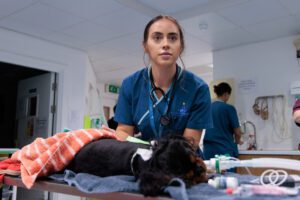Animals
Canine
Summary
Chiari-like malformation (CM) is a developmental abnormality of the craniocervical junction that is common in the Griffon Bruxellois (GB) breed with an estimated prevalence of 65%. This disease is characterized by overcrowding of the neural parenchyma at the craniocervical junction and disturbance of cerebrospinal fluid (CSF) flow. The most common clinical sign is pain either as a direct consequence of CM or neuropathic pain as a consequence of secondary syringomyelia. The etiology of CM remains unknown but genetic factors play an important role. To investigate the genetic complexity of the disease, a quantitative trait locus (QTL) approach was adopted. A total of 14 quantitative skull and atlas measurements were taken and were tested for association to CM. Six traits were found to be associated to CM and were subjected to a whole-genome association study using the Illumina canine high density bead chip in 74 GB dogs (50 affected and 24 controls). Linear and mixed regression analyses identified associated single nucleotide polymorphisms (SNPs) on 5 Canis Familiaris Autosomes (CFAs): CFA2, CFA9, CFA12, CFA14 and CFA24. A reconstructed haplotype of 0.53 Mb on CFA2 strongly associated to the height of the cranial fossa (diameter F) and an haplotype of 2.5 Mb on CFA14 associated to both the height of the rostral part of the caudal cranial fossa (AE) and the height of the brain (FG) were significantly associated to CM after 10 000 permutations strengthening their candidacy for this disease (P = 0.0421, P = 0.0094 respectively). The CFA2 QTL harbours the Sall-1 gene which is an excellent candidate since its orthologue in humans is mutated in Townes-Brocks syndrome which has previously been associated to Chiari malformation I. Our study demonstrates the implication of multiple traits in the etiology of CM and has successfully identified two new QTL associated to CM and a potential candidate gene



